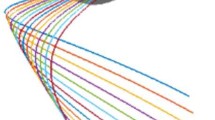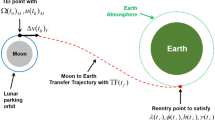Abstract
To design a free-return orbit for manned lunar mission based on low earth orbit (LEO) rendezvous, an adaptive LEO-phase free-return orbit design method based on high-precision dynamics model is proposed. First, the radius of perilune and the absolute value of perilune velocity are decoupled using a coordinate system rotation, which is derived from moon-centric local vertical and local horizontal instantaneous coordinate system at the time of perilune. The two Euler rotation angles and the absolute value of perilune velocity are used as independent design variables because their initial values are easy to guess. Next, a two-segment numerical integration strategy is proposed to calculate orbital elements at the moments of trans-lunar injection and free-return vacuum perigee. Subsequently, an optimization algorithm software package for solving large-scale nonlinear sequential quadratic programming problems (SQP_snopt) is employed to search the objective free-return orbit with a fixed trans-lunar injection inclination and the other two constraints on radiuses of perigee at the times of trans-lunar injection and vacuum perigee. After that, an iteration algorithm is devised to adjust trans-lunar injection window for adaptive LEO-phase. Finally, numerical results show a fast and accurate performance of the direct optimization method, which can provide valuable references to manned lunar missions based on LEO rendezvous.





Similar content being viewed by others
References
Lunney G. Discussion of several problem areas during the Apollo 13 operation [C]. AIAA 7th Annual Meeting and Technical Display, Houston, Texas. 1970
Miele, A.: Theorem of image trajectories in earth moon space [J]. Acta Astronautica. 6(51), 225–232 (1960)
Schwaniger, A.J.: Trajectories in the earth-moon space with symmetric free-return properties [R]. In: NASA Technical Note D-1833 (1963)
Jesick, M., Ocampo, C.: Automated generation of symmetric lunar free-return trajectories [J]. J. Guid. Control. Dyn. 34(1), 98–106 (2011)
Egorov V A. Three-dimensional lunar trajectories [R]. NASA Technical Translation, F-504,1969
Farquhar, R.W.: Dunham D W. a new trajectory concept for exploration the earth’s geomagnetic tail [J]. J. Guid. Control. Dyn. 4(2), 192–196 (1980)
He, B.Y., Li, H.Y., Zhou, J.P.: Solution domain analysis of earth-moon quasi-symmetric free-return orbits [J]. Trans. Japan Soc. Aero. Space Sci. 60(4), 195–201 (2017)
Egorov, V.A.: Certain problems of moon flight dynamics [M]. International Physical Index Inc, New York (1958)
Tolson, R.H.: Geometrical characteristic of lunar orbits established from earth-moon trajectories [R]. NASA Technical Note D-1780, Washington DC (1963)
Penzo A P. An analysis of free-flight circumlunar trajectories [C]. AIAA Astrodynamicss conference, new haven, Connecticut, USA, August, 19–21. 1963
Dallas, S.S.: Moon-to-earth trajectories [C]. AIAA Astrodynamics Conference, New Haven (1963)
Gibson F T. Application of the matched conic model in the study of circumlunar trajectories [R]. NASA Project Apollo Working Paper No.1066. 1963
Peng, Q.B., Shen, H.X., Li, H.Y.: Free return orbit design and characteristics analysis for manned lunar mission [J]. Sci. China Technol. Sci. 54(12), 3243–3250 (2011)
Li, J.Y., Gong, S.P., Baoyin, H.X.: Generation of multi-segment lunar free-return trajectories [J]. J. Guid. Control. Dyn. 36(3), 765–775 (2013)
Wilson S W. A pseudostate theory for the approximation of three-body trajectories [C]. AAS/AIAA Astrodynamics Conference, AAS/AIAA Astrodynamics Conference, Santa Barbaba, 1970
Wilson, R.S., Howell, K.C.: Trajectory design in the sun-earth-moon system using lunar gravity assists. J. Spacecr. Rocket. 35(2), 191–198 (1998)
Byrnes, D.: Application of the pseudostate theory to the three body lambert problem [J]. J. Astronaut. Sci. 37, 221–232 (1989)
Ramanan, R.: Integrate algorithm for lunar transfer trajectories using a pseudo state technical[J]. J. Guid. Control. Dyn. 25(2), 946~952 (2002)
Luo, Q.Q., Yin, J.F., Han, C.: Design of earth-moon free-return trajectories [J]. J. Guid. Control. Dyn. 36(1), 263–271 (2013)
Zhang, H.L., Luo, Q.Q., Han, C.: Accurate and fast design algorithm for free-return lunar flyby trajectories [J]. Acta Astronautica. 102(5), 14–26 (2014)
Stanley, D., Cook, S., Connolly, J., et al.: NASA’s exploration system architecture study [R]. NASA-TM-2005-214062. In: November (2005)
Yan, H., Gong, Q.: High-accuracy trajectory optimization for a trans-earth-lunar mission [J]. J. Guid. Control. Dyn. 34(4), 1219–1227 (2011)
He, B.Y., Li, H.Y., Zhang, B.: Analysis of transfer orbit deviation propagation mechanism and robust design for manned lunar landing [J]. Acta Phys. Sin. 62(19), 91–98 (2013)
Yim, S.Y., Baoyin, H.X.: High latitude landing circumlunar free return trajectory design [J]. Aircraft. Engin. and Aeros. Techn. 87(4), 380–391 (2015)
Berry, R.L.: Launch window and trans-lunar orbit, lunar orbit, and trans-earth orbit planning and control for the Apollo 11 lunar landing mission [R]. AIAA 8th Aerospace Sciences Meeting, AIAA 70–0024, New York (1970)
Topputo, F.: On optimal two-impulse earth-moon transfers in a four-body model [J]. Celestial Mech. Dyn. Astr. 117(3), 279–313 (2013)
Shen, H.X., Zhou, J.P., Peng, Q.B., et al.: Point return orbit design and characteristics analysis for manned lunar mission [J]. Sci. China Technol. Sci. 55(9), 2561–2569 (2012)
Gill, P.E., Murray, W., Saunder, M.A.: SNOPT: an SQP algorithm for large-scale constrained optimization [J]. Siam J. Optim. 12(4), 979–1006 (2002)
Garn M, Qu M, and Chrone J, et al. NASA’s planned return to the moon: global access and anytime return requirement implications on the lunar orbit insertion burns [C]. AAS/AIAA Astrodynamicss Specialist Conference and Exhibit, August. 2008
Acknowledgements
This work was supported by the National Natural Science Foundation of China (Grant No. 11702330) and National Defense Science and Technology Innovation Special Zone Project.
Author information
Authors and Affiliations
Corresponding author
Additional information
Publisher’s Note
Springer Nature remains neutral with regard to jurisdictional claims in published maps and institutional affiliations.
Rights and permissions
About this article
Cite this article
He, By., Li, Hn. & Zheng, Aw. Adaptive LEO-Phase Free-Return Orbit Design Method for Manned Lunar Mission Based on LEO Rendezvous. J Astronaut Sci 66, 446–459 (2019). https://doi.org/10.1007/s40295-019-00182-3
Published:
Issue Date:
DOI: https://doi.org/10.1007/s40295-019-00182-3




